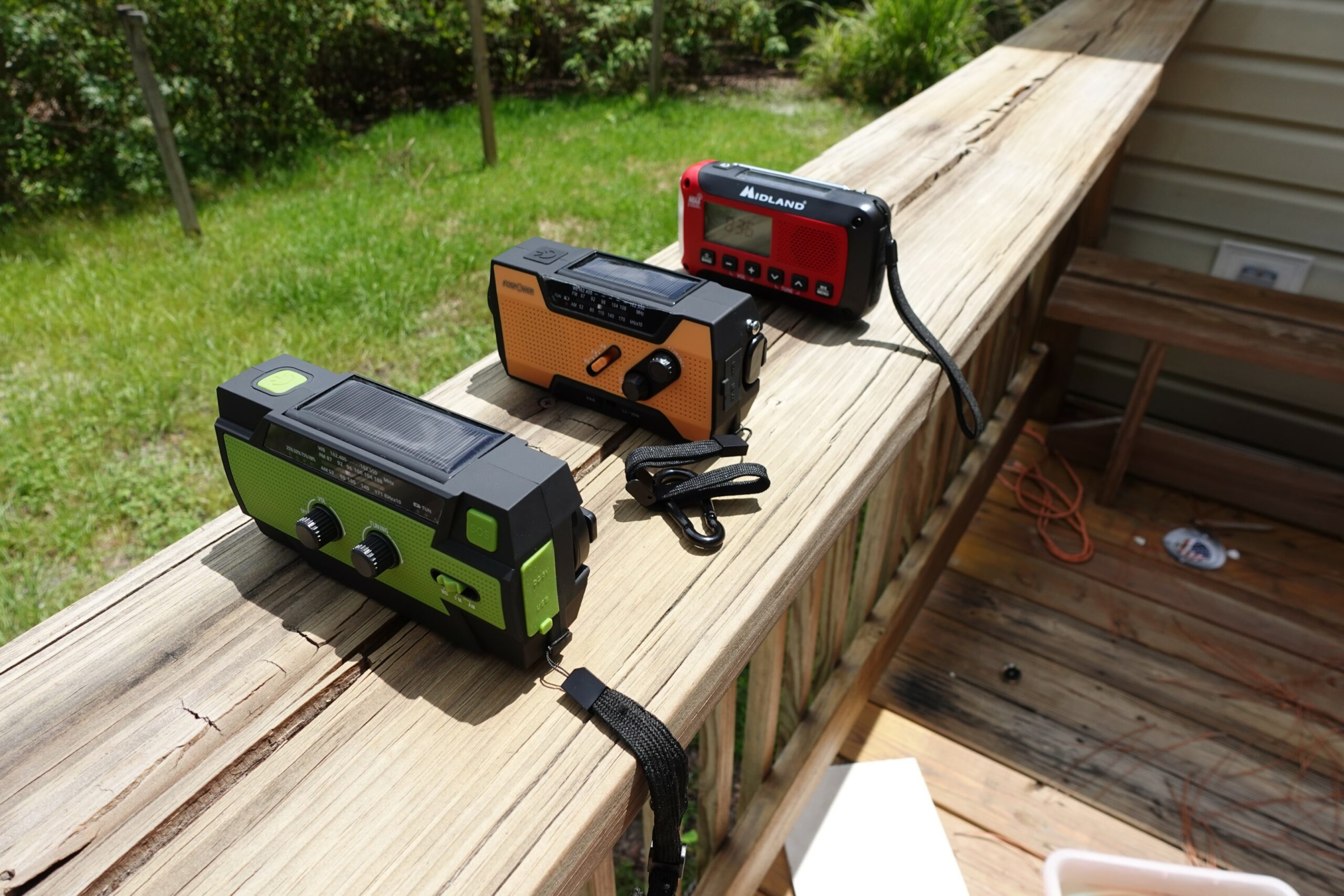When storms knock out power and cell towers start failing, how will you know what’s happening? The fact is, you won’t – not without the best emergency weather radio at your disposal. Often overlooked but considered an essential piece of equipment by our team, these clever devices are your lifeline when normal communication channels fail.
Unlike smartphones, weather alert radios don’t need cell service or internet to function. They are designed and built specifically to catch official weather alerts even in the worst conditions.
Let’s take a quick look at why emergency radios for disaster deserve a spot in every home emergency kit.
Why Weather Alert Radios Are Essential for Emergency Preparedness
Imagine a major storm hitting. Power’s out. Cell towers are down. You are potentially facing water damage and flooding, but you can’t be sure, as your phone is dying, which means you have no idea if you should evacuate or stay put. This might sound a little far-fetched, but it happens somewhere in America far more often than you might imagine.
NOAA radios for emergencies act as your connection to official information when everything else fails. These handy devices receive broadcasts from the National Oceanic and Atmospheric Administration’s radio stations, which operate 24/7 and transmit watches, warnings, and emergency messages.
What makes weather alert radios so valuable is their reliability when other systems crash. They don’t depend on the Internet or cell service. Many models include multiple power options – batteries, hand cranks, solar panels – ensuring they’ll work during extended outages.
The key features that make these essential include:
- Battery backup systems that activate when power fails
- Portable designs that can be grabbed during evacuations
- Multiple power sources for true independence
You can think of your weather radio as insurance, of sorts. You hope you never need it, but you will be extremely grateful to have one when disaster lands at your door.
Key Features to Look for in a Weatherband Radio
Of course, there is a wide range of weather alert radios on the market, some of which are far superior to others. There are also a ton of features to choose from, but in general, the average person should be concerned only with the following:
Reception Quality and Alert Accuracy
The best emergency weather radio should reliably tune to NOAA frequencies (162.400 to 162.550 MHz). A good antenna improves reception range and quality.
Many quality models include S.A.M.E. technology (Specific Area Message Encoding), which lets you program your county code to receive only alerts relevant to your location. This prevents alert fatigue from warnings about conditions that don’t affect you.
Power Options
During long emergencies, power flexibility becomes a prerequisite. The most reliable emergency radios for disaster situations offer multiple charging methods:
- Standard battery operation
- Solar charging panels
- Hand-crank generators
- AC adapters for normal use
This redundancy means you’re never without options. Even if batteries die (and the sun isn’t shining), a few minutes of cranking can provide enough power for critical updates.
Durability and Portability
When evacuation becomes necessary, especially during flooding from rain, you need a radio that is reliably water-resistant and able to take general abuse. To that end, try to look for:
- Water-resistant construction (check IPX ratings)
- Impact-resistant cases with protective bumpers
- Compact size that fits in emergency kits
- Bright colors to find easily in dim light
The ideal sweet spot combines portability with toughness. In other words, it should be small enough to carry, but durable enough to survive rough handling during stressful situations.
Top Recommended Weatherband Radios for Emergencies
After testing dozens of models during actual emergencies, these three weather alert radios consistently delivered when it mattered, based on reception quality, durability, and reliability:
Midland ER310 Emergency Radio

Priced at around $70, this well-rounded performer features digital tuning for all seven NOAA weather channels and an automatic alert system. The 2,600 mAh rechargeable battery provides extended operation, while solar panels and a hand crank offer backup charging. The ultrasonic dog whistle (handy for search teams) and LED flashlight with SOS function add extra emergency utility.
Sangean MMR-88 Emergency Radio

Known for exceptional reception, this compact NOAA radio for emergencies receives both AM/FM and all NOAA weather bands. For just $59, its water-resistant design handles rain and splashes surprisingly well. While the battery is smaller than some competitors, the efficient hand crank provides meaningful power – one minute of cranking yields about five minutes of radio operation.
Kaito KA500 Voyager

For around $65, this rugged NOAA radio for emergencies is made of impact-resistant plastic with rubber bumpers. In addition to standard alerts, it receives shortwave radio for international news during widespread emergencies. Multiple charging options include solar, hand crank, USB, AA batteries, and AC power.
How to Properly Set up and Test Emergency Radios for Disaster
While it’s all well and good having the best emergency weather radio, it won’t help if you don’t know how to use it during severe weather events. Fortunately, they are quite simple to use. If you don’t know how, just follow these steps:
- Find your local NOAA frequency: Visit the NOAA website to identify which frequency provides the strongest signal in your area.
- Program S.A.M.E. codes: If your radio supports this feature, enter your specific county code to receive geographically targeted alerts.
- Test weekly: NOAA conducts weekly tests of the emergency alert system. Check your radio during these tests.
- Establish a battery rotation: For disposable batteries, mark them with dates and rotate fresh ones every six months. For rechargeable models, perform a full discharge/recharge cycle quarterly.
- Practice in the dark: Can you find and operate your radio without light? Practice these skills before a real emergency.
Regular testing isn’t a bad idea, either. Try to get into the habit of using it once in a while, just to ensure everything is working as it should be. NOAA radios for emergencies are commonly thrown on a garage shelf and forgotten about, but if they go unused for years, they might develop issues. Once a year should be fine.
Emergency Preparedness Tips
Weather alert radios form just one component of comprehensive emergency readiness. To fully immerse yourself in disaster avoidance, you might want to consider these complementary preparations:
Build a complete emergency kit: Beyond your radio, assemble supplies including non-perishable food, water (one gallon per person per day), flashlights, first aid supplies, and medications.
Create a communication plan: Designate an out-of-area contact everyone can call. When local lines jam, long-distance calls often go through more easily.
Practice emergency drills: Run through evacuation routes and meeting points with your household. Include children in age-appropriate ways.
Consider backup power solutions: Small power banks or portable generators can keep essential medical devices running and provide additional charging options for your emergency radios for disaster situations.
Remember: emergencies rarely announce themselves in advance! The best time to prepare is now, before alerts start blaring through your new radio.
Your Connection to Safety
When normal information channels go dark, the best emergency weather radio becomes your most reliable link to life-saving updates. By selecting one with the right features for your situation, you’re taking a firm step toward protecting yourself and your loved ones.
Either way, please don’t wait until it’s too late! Heavy rains and flooding often follow severe weather alerts – the very situations your radio will warn you about.

When water damage arrives after a storm, WetReset is ready to help restore your home to its former glory. Contact us for emergency water damage solutions, and while you’re preparing, add that weather alert radio to your safety kit… Your future self will thank you!



